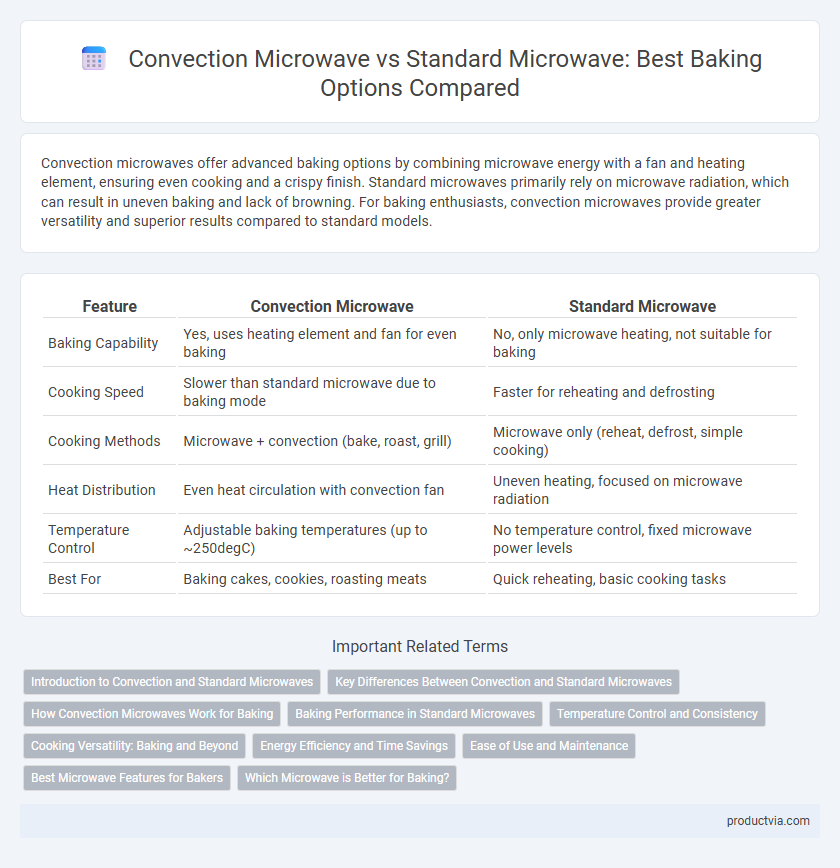Convection microwaves offer advanced baking options by combining microwave energy with a fan and heating element, ensuring even cooking and a crispy finish. Standard microwaves primarily rely on microwave radiation, which can result in uneven baking and lack of browning. For baking enthusiasts, convection microwaves provide greater versatility and superior results compared to standard models.
Table of Comparison
| Feature | Convection Microwave | Standard Microwave |
|---|---|---|
| Baking Capability | Yes, uses heating element and fan for even baking | No, only microwave heating, not suitable for baking |
| Cooking Speed | Slower than standard microwave due to baking mode | Faster for reheating and defrosting |
| Cooking Methods | Microwave + convection (bake, roast, grill) | Microwave only (reheat, defrost, simple cooking) |
| Heat Distribution | Even heat circulation with convection fan | Uneven heating, focused on microwave radiation |
| Temperature Control | Adjustable baking temperatures (up to ~250degC) | No temperature control, fixed microwave power levels |
| Best For | Baking cakes, cookies, roasting meats | Quick reheating, basic cooking tasks |
Introduction to Convection and Standard Microwaves
Convection microwaves combine microwave energy with a heating element and fan, enabling even heat distribution for baking and roasting, unlike standard microwaves that rely solely on microwave radiation for cooking. Standard microwaves primarily heat food through electromagnetic waves causing water molecules to vibrate, which results in quicker cooking but lacks the browning and crisping effects needed for baking. The convection feature enhances versatility, making convection microwaves suitable for baking cakes, cookies, and pastries with results closer to conventional ovens.
Key Differences Between Convection and Standard Microwaves
Convection microwaves combine traditional microwave heating with a built-in fan and heating element to circulate hot air, enabling even baking and browning similar to conventional ovens. Standard microwaves rely solely on microwave radiation to heat food quickly but lack the capability to bake or crisp effectively. The key difference lies in the convection microwave's ability to provide dual cooking functions, making it more versatile for baking tasks compared to the limited baking options of standard microwaves.
How Convection Microwaves Work for Baking
Convection microwaves use a built-in fan and heating element to circulate hot air evenly around the food, enabling uniform baking results similar to traditional ovens. This airflow promotes better browning and crisping, making convection microwaves ideal for baking cakes, cookies, and pastries. Standard microwaves rely on microwave radiation alone, which heats food unevenly and lacks the precise temperature control necessary for effective baking.
Baking Performance in Standard Microwaves
Standard microwaves use microwave radiation to cook food quickly but often produce uneven baking results due to lack of consistent heat distribution and limited browning capabilities. Baking performance in standard microwaves is generally inferior to convection models as they cannot create the dry, hot environment required for proper crust formation in baked goods. This makes standard microwaves less suitable for recipes that demand precise baking textures, such as cakes and pastries.
Temperature Control and Consistency
Convection microwaves offer precise temperature control through integrated heating elements and fan-assisted air circulation, ensuring even baking and consistent results. Standard microwaves rely primarily on microwave radiation, which can lead to uneven heating and less predictable baking outcomes. The enhanced temperature regulation in convection models makes them superior for recipes requiring uniform heat distribution and accurate baking temperatures.
Cooking Versatility: Baking and Beyond
Convection microwaves offer enhanced cooking versatility by combining microwave energy with a built-in fan and heating element, enabling even baking and roasting in addition to reheating. Standard microwaves primarily use microwave radiation for quick heating and defrosting but lack the ability to brown or crisp foods effectively. For baking and culinary tasks requiring precise temperature control and texture, convection microwaves provide superior performance beyond the basic functions of standard models.
Energy Efficiency and Time Savings
Convection microwaves combine microwave energy with a built-in fan to circulate hot air, allowing faster and more even baking compared to standard microwaves. This dual heating mechanism enhances energy efficiency by reducing cooking times and heat wastage, making it ideal for baking tasks. Standard microwaves primarily rely on microwave radiation alone, which often results in longer baking times and less energy-efficient performance.
Ease of Use and Maintenance
Convection microwaves offer enhanced baking options by combining microwave heating with a built-in fan and heating element, allowing for even cooking and browning that standard microwaves lack. Ease of use varies as convection models typically include preset baking programs, but may require a learning curve for optimal results, while standard microwaves are simpler with basic settings. Maintenance is more involved for convection microwaves due to additional components like the fan and heating element, needing regular cleaning to prevent grease buildup, whereas standard microwaves require minimal upkeep.
Best Microwave Features for Bakers
Convection microwaves combine microwave energy with a heating element and fan to circulate hot air, delivering even baking results and crisp textures ideal for bread and pastries. Standard microwaves use only microwave radiation, which can cause uneven cooking and lack the browning necessary for many baked goods. For bakers seeking versatile kitchen appliances, convection microwaves offer superior temperature control, multiple cooking modes, and enhanced performance for baking, roasting, and grilling compared to standard microwaves.
Which Microwave is Better for Baking?
Convection microwaves offer superior baking performance compared to standard microwaves due to their built-in heating elements and fans that circulate hot air, ensuring even cooking and browning. Standard microwaves rely solely on microwave radiation, which tends to cook food unevenly and lacks the crisping ability essential for baking. For consistent baked goods like cakes, cookies, and bread, convection microwaves provide more precise temperature control and improved texture.
Convection Microwave vs Standard Microwave for baking options Infographic

 productvia.com
productvia.com